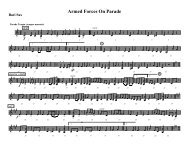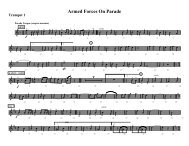SEPARATION OF BLUE DEXTRAN, CYTOCHROME C AND ...
SEPARATION OF BLUE DEXTRAN, CYTOCHROME C AND ...
SEPARATION OF BLUE DEXTRAN, CYTOCHROME C AND ...
Create successful ePaper yourself
Turn your PDF publications into a flip-book with our unique Google optimized e-Paper software.
Lab<br />
501<br />
Introduction<br />
Experiment No. 1<br />
H9SU BIOCHEMISTRY LABORATORY SERIES - Fall 2010<br />
<strong>SEPARATION</strong> <strong>OF</strong> <strong>BLUE</strong><br />
<strong>DEXTRAN</strong>, <strong>CYTOCHROME</strong> C<br />
NAME<br />
SECTION LOCKER<br />
<strong>AND</strong> VITAMIN B 12 ON<br />
SEPHADEX G-100 <strong>AND</strong> G-25<br />
INSTRUCTOR DATE<br />
Porous Sephadex gels such as Sephadex G-100,<br />
G-150 and G-200 have found extensive application<br />
for the separation and study of polymers such as<br />
proteins, polysaccharides and nucleic acids.<br />
Sephadex gels are of particular value because<br />
they generally do not destroy the integrity of labile<br />
biological samples.<br />
In experiment No. 1 Blue Dextran 2,000 Mw<br />
2,000,000; cytochrome C, M w 25,000; and Vitamin<br />
B 12,<br />
M.W. 1,357; will be separated on Sephadex<br />
G-100. The eluant will be 0.1 M sodium chloride.<br />
Sephadex G-100 has a molecular weight exclusion<br />
value of 100,000 for dextrans. Therefore, Blue<br />
Dextran 2,000 with an average molecular weight of<br />
2,000,000 will be used to determine the bed void<br />
volume (Vo). The colored compounds will be<br />
detected visually.<br />
Experiment No. 2<br />
Sephadex G-25 has found widespread application<br />
for the rapid, mild and efficient desalting of<br />
polymers such as peptides, proteins, nucleic acids<br />
and polysaccharides. Compounds with molecular<br />
weights of less than 5,000 can also be fractionated<br />
and separated from compounds with molecular<br />
weights greater than 5,000. In Experiment No. 2,<br />
Vitamin B 12 will be separated from a blue dextran<br />
and Cytochrome C. Since the blue dextran and<br />
Cytochrome C with molecular weights of 2,000,000<br />
and 25,000 respectively, both exceed the<br />
exclusion limit of 5,000 for Sephadex G-25, they<br />
will appear as a green band moving in the void<br />
volume. The green band will be used to determine<br />
the void volume of the column.<br />
General Materials<br />
1. Kontes Flexcolumn, 0.7 x 30 cm.<br />
2. 30 small test tubes and rack.<br />
3. Small pipette or dropper<br />
4. Reservoir and connecting tubing.<br />
5. Ring stand and clamps.<br />
6. 25 mL graduated cylinder.<br />
7. Eluant - 0.1 M sodium chloride solution.<br />
8. Dextran - B 12 vial, which contains 9 mg Blue<br />
Dextran 2,000, 9 mg Cytochrome C, and 2.7<br />
mg Vitamin B .<br />
12<br />
9. 0.75 g of Sephadex G-100 Superfine<br />
(Experiment No. 1).<br />
10. 2.5 g of Sephadex G-25 Fine (Experiment No.<br />
2).<br />
11. Fraction Collector<br />
Column Preparation<br />
1. Erect the column with the top cap removed.<br />
Check vertical position with a plumb line or<br />
carpenter’s level.<br />
2. Run a small volume of eluant through the<br />
column so that air bubbles do not remain in or<br />
below the nylon net. Forcing eluant back and<br />
forth through the net with the aid of a syringe<br />
or yellow automatic pipette attached to the<br />
capillary outlet tubing often facilitates this<br />
procedure.<br />
3. Close the stopcock at the bottom of the<br />
column when eluant remains in the column to<br />
a height of approximately 1 cm.<br />
Column Packing and Stabilization*<br />
1. Rapid swelling and packing procedure.<br />
a. Bring approximately 50 mL of eluant (0.1<br />
M NaCl) to boiling.<br />
b. Add 15 mL of boiling eluant to a 25 mL<br />
graduated cylinder.<br />
c. Gradually and with mixing, add the<br />
preweighed gel to the eluant-containing<br />
cylinder.<br />
d. Add additional eluant to give a total
501 - <strong>SEPARATION</strong> - Page 2<br />
volume of 20-25 mL.<br />
e. Mix gently with a stirring rod for 15<br />
minutes.<br />
f. Allow the gel to settle for 15 minutes.<br />
g. With a dropper remove excess clear<br />
eluant so that a total volume of 18 mL of<br />
gel and eluant remains in the cylinder.<br />
h. Slurry the gel; if bubbles remain below the<br />
surface of the slurry, add slightly more<br />
eluant (2-3 mL).<br />
2. Smoothly pour the gel slurry into the column<br />
until it is full. If air bubbles appear in the bed<br />
and do not rise to the surface, remove the gel<br />
from the column, add 3-4 mL of eluant to the<br />
gel, stir and repour the gel slurry.<br />
3. After 5 minutes the column outlet may be<br />
opened.<br />
4. As space allows, add to the column any gel<br />
slurry remaining in the graduated cylinder.<br />
5. Immediately fill the column with additional 0.1<br />
M NaCl.<br />
6. Adjust the stopcock, so that a flow rate of 0.1-<br />
0.15 mL/min is obtained.<br />
7. Stabilize the bed by washing with eluant for 30<br />
minutes; approximately 3-4.5 mL of eluant<br />
should be collected. A final bed height of<br />
approximately 25 cm should be established.**<br />
Sample Preparation<br />
Dissolve the contents of the Dextran-B 12 vial in 3<br />
mL of hot distilled water. Be sure the sample is<br />
completely dissolved.<br />
Sample Application<br />
1. Remove the column top cap and carefully<br />
remove most of the eluant above the bed<br />
surface with pipette or dropper. WARNING!<br />
DO NOT disturb the bed surface.<br />
2. Let the eluant remaining in the column flow<br />
into the bed. The top of the bed actually<br />
appears to be dry.<br />
3. Close the stopcock.<br />
4. Carefully add 0.3 mL of the sample solution<br />
dropwise to the bed surface. Do not disturb<br />
the surface of the bed.<br />
5. Open the column outlet and begin collecting<br />
the eluant emerging from the column in a<br />
fraction collector set of 10-drop fractions. The<br />
volume of eluant collected from the time the<br />
sample is placed on the bed until the Blue<br />
Dextran 2,000# appears in the eluant is called<br />
the void volume (V o).<br />
To determine this you<br />
will need to measure the volume of the<br />
fractions (average the volumes of several<br />
fractions) and multiply by the number of<br />
fractions.<br />
6. Immediately after all of the sample has flowed<br />
into the bed, carefully add three small portions<br />
(each approximately 4 drops) of eluant to the<br />
top of the bed so that the sample is washed<br />
evenly into the bed.<br />
7. Carefully fill the volume above the bed with<br />
eluant.<br />
8. Elute at a flow rate of approximately 0.1-0.15<br />
mL/min. Adjust the head pressure or<br />
stopcock so that the above flow rate is<br />
obtained.<br />
9. Keep the eluant in the reservoir at a constant<br />
level during the experiment if a Mariotte flask<br />
or similar device is not used.<br />
Collection of Fractions<br />
1. As the Blue Dextran approaches the bottom of<br />
the bed, collect 10-15 drop fractions<br />
(approximately 0.5-0.75 mL each) in the small<br />
numbered test tubes. Be sure to record the<br />
volume of clear eluant collected in the<br />
graduated cylinder or by the technique<br />
described above for the V o determination.<br />
2. Collect approximately 25 fractions. Collect<br />
two fractions after the last component is no<br />
longer visible in the collected fractions.<br />
3. Assign a number value from one to four to the<br />
tubes containing colored components which<br />
corresponds to the relative intensity of the<br />
color in each tube. Tubes which are colorless<br />
assign a value of zero.<br />
4. Record the assigned number for color<br />
intensity.<br />
5. Measure the total volume in which each<br />
component is eluted from the column. Record<br />
this information for later calculation of dilution<br />
factors.<br />
6. Mark the top of the bed by placing a piece of<br />
tape on the outside of the column. Empty the
Calculations<br />
column of gel. Fill the column with water<br />
to the tape mark and measure the volume<br />
in a graduated cylinder. This volume is<br />
equivalent to the bed volume (V t ) . Record<br />
this volume.<br />
1. In each experiment plot the relative intensity of<br />
the color of each component versus the<br />
corresponding fraction number of graph paper.<br />
2. The elution volume for a component<br />
represents the volume of effluent collected<br />
from the time the sample is placed on the<br />
column bed to the time the component<br />
appears in the effluent. Consider this point to<br />
be the effluent volume to the fraction where<br />
the component first shows its half maximum<br />
color intensity.<br />
3. Estimate the efficiency of separation from the<br />
graph. (See the booklet in lab.)<br />
4. Calculate dilution factors for the components.<br />
5. Calculate V i. Then calculate the Kd and Kav<br />
values for the components. Assume that the<br />
elution volume of Blue Dextran 2,000 is equal<br />
to the void volume.<br />
*NOTE. The packing and stabilization procedures<br />
used in these experiments are designed so that<br />
the experiment can be completed with a 3 hour<br />
laboratory period. For more exacting work, gel<br />
swelling, bed packing and stabilization procedures<br />
described in Sephadex technical data sheets and<br />
the booklet, “Sephadex-Gel Filtration in Theory<br />
and Practice,” should be employed.<br />
**Longer beds may be used for greater resolution<br />
and should be packed by the procedure described<br />
in the booklet. “Sephadex-Gel Filtration in Theory<br />
and Practice.”<br />
#See Technical Data Sheet No. 8.<br />
501 - <strong>SEPARATION</strong> - Page 3





